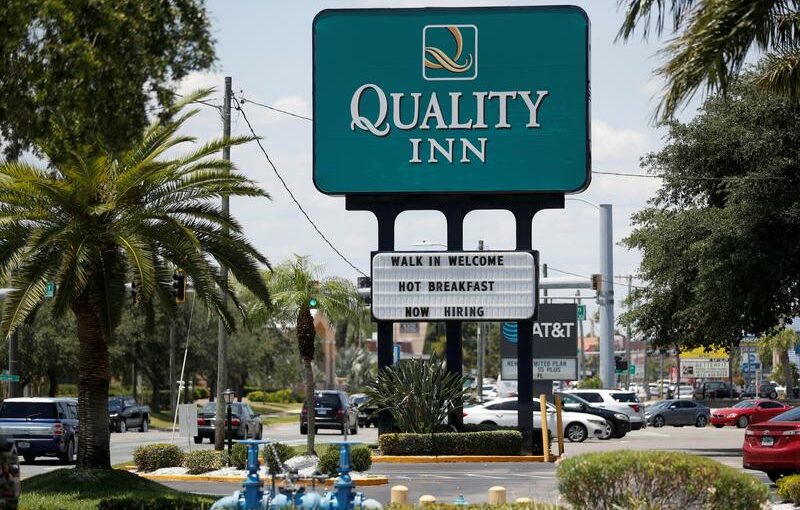WASHINGTON (Reuters) – New U.S. state-level data and accompanying studies show a group of largely Republican governors did not yet get the job boom they hoped for by cutting federal unemployment benefits this summer, but the loss of the stipend did appear to prompt some of the unemployed to take jobs.
Underlying that topline conclusion, however, is also evidence of a more nuanced reshuffling among different employment categories that could have bearing on the economy’s performance in the critical months to come.
Separate analyses released last week, using different data sets and methods, concluded that the 26 states that cut a $300 weekly federal unemployment stipend this summer did see the unemployed find a job at a faster rate, perhaps as much as 6 percentage points, than did the 24 states planning to continue the benefit at least until its scheduled national expiration in early September.
However, the states that cut benefits saw worse results in pulling people back into the formal labor force, to the degree that overall job growth in the two groups of states was nearly identical from May through July. In the U.S. government’s regular employment surveys, people are considered unemployed only if they are looking for a job; others are considered out of the labor force until they start a job or begin a job search.
While the end of federal supplemental unemployment benefits may have motivated people to take jobs in the one group of states, “in non-cutoff states employment rose almost as much by bringing people back into the labor force,” meaning people who had not been looking for work at all in the previous month had started a search and found a job, wrote Jed Kolko, chief economist for job site Indeed.
Goldman Sachs economists reached a similar conclusion.
Though neither offered a comprehensive explanation for why that difference may have emerged between the two groups of states, the finding could spell trouble for continued job gains this fall if coronavirus cases continue to surge. Federal Reserve officials and others expect robust employment gains in the coming months as schools reopen, daily life edges back to normal – and the extra federal unemployment benefits expire nationally.
Arguments about the continued need for the benefits, pressed most pointedly by Republican state leaders, emerged in the spring as national coronavirus case rates collapsed amid the first rounds of COVID-19 vaccinations, job openings soared, and employers complained they had trouble getting people to come back to work.
The Goldman Sachs study noted that the cut in benefits appeared to have its biggest impact on lower-paid workers in the leisure and hospitality industry – an intuitive finding since the weekly federal benefit represents a higher proportion of the pay they would receive from returning to work.
Yet those jobs are also the most susceptible if the surge in the virus changes people’s willingness to participate in “close contact” services.
At the same time, Goldman noted that its findings “suggest” those who left the labor force since the start of the pandemic “did so for non-financial reasons such as concern about Covid.” Just as they did not flock back to the job market this summer in the states that cut benefits, they may not do so in the other states this fall if the disease is spreading.
“Our finding that benefit expiration did not encourage labor force participation was a somewhat negative surprise, and increases the risk that some workers may be slow to return to the labor force, particularly if the Delta variant increases concerns around health risk,” wrote Goldman economists Joseph Briggs and Ronnie Walker.
Some of the major states that cut benefits, including Florida and Texas, also saw the start last month of an overwhelming wave of new coronavirus cases.
Goldman’s base case remains for strong employment growth through the end of the year, with 3.4 million jobs added through December, and a 4.1% year-end unemployment rate that’s below some economists’ estimation of full employment.
IMPACT ON CONSUMPTION
Both the numbers of unemployed and those out of the labor force increased markedly during the pandemic, and policymakers hope improved hiring among each group will trim or even fully reclaim the 5.7 million jobs still missing from before the pandemic.
U.S. firms added jobs at a rapid pace this summer, nearly a million a month in June and July. But the record level of job openings suggested the job gains could have been even greater, perhaps by as much as 400,000, Goldman estimated. On that basis, the national expiration of unemployment benefits, slated for early September, would prompt an additional 1.5 million people to take jobs by the end of the year, Goldman estimated.
A similar study here by a group including University of Massachusetts Amherst professor Arindrajit Dube also concluded the unemployed were more likely to find jobs in states that cut benefits, and saw “a modest, but precisely measured increase in the probability of job finding in the Withdrawal states,” of about 4.4 percentage points.
Yet they concluded it was ultimately a bad deal for the states involved. The group had a slight increase in earnings, but lost far more in federal benefits, with a net drop of consumption in those states of about $2 billion.
Goldman economists concurred that the loss of unemployment benefits will likely contribute to an upcoming drag on the economy as an array of pandemic-era programs expire.
<^^^^^^^^^^^^^^^^^^^^^^^^^^^^^^^^^^^^^^^^^^^^^^^^^^^^^^^^^^^
Red state roll off here
A (mostly) red state roll off
^^^^^^^^^^^^^^^^^^^^^^^^^^^^^^^^^^^^^^^^^^^^^^^^^^^^^^^^^^^>
Source: Read Full Article
